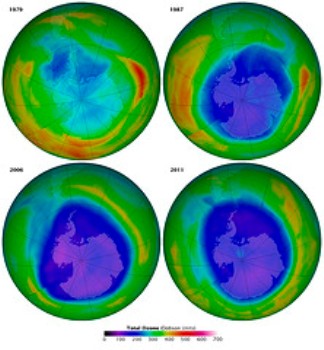Feb 2 2013
Depletion of Antarctic ozone is a more important factor than increasing greenhouse gases in shifting the Southern Hemisphere jet stream in a southward direction, according to researchers at Penn State.
 Watching the Ozone Hole Before and After the Montreal Protocol. Credit: NASA Earth Observatory
Watching the Ozone Hole Before and After the Montreal Protocol. Credit: NASA Earth Observatory
"Previous research suggests that this southward shift in the jet stream has contributed to changes in ocean circulation patterns and precipitation patterns in the Southern Hemisphere, both of which can have important impacts on people's livelihoods," said Sukyoung Lee, professor of meteorology.
According to Lee, based on modeling studies, both ozone depletion and greenhouse gas increase are thought to have contributed to the southward shift of the Southern Hemisphere jet stream, with the former having a greater impact. But until now, no one has been able to determine the extent to which each of these two forcings has contributed to the shift using observational data.
"Understanding the differences between these two forcings is important in predicting what will happen as the ozone hole recovers," she said. "The jet stream is expected to shift back toward the north as ozone is replenished, yet the greenhouse-gas effect could negate this."
Lee and her colleague, Steven Feldstein, professor of meteorology, developed a new method to distinguish between the effects of the two forcings. The method uses a cluster analysis to investigate the effects of ozone and greenhouse gas on several different observed wind patterns.
"When most people look at ozone and greenhouse gases, they focus on one wind pattern, but my previous research suggests that, by looking at several different but similar patterns, you can learn more about what is really happening," said Feldstein.
In their study, the researchers analyzed four wind patterns. The first wind pattern corresponded to an equatorward shift of the midlatitude westerlies toward the equator. The second pattern also described an equatorward shift, but included a strong tropical component. The third pattern corresponded to a poleward shift of the westerlies toward the South Pole with a weakening in the maximum strength of the jet. The fourth pattern corresponded to a smaller poleward jet shift with a strong tropical component.
In addition to their novel inclusion of more than one wind pattern in their analysis, the scientists investigated the four wind patterns at very short time scales.
"Climate models are usually run for many years; they don't look at the day-to-day weather," said Feldstein. "But we learned that the four wind patterns fluctuate over about 10 days, so they change on a time scale that is similar to daily weather. This realization means that by taking into account fluctuations associated with the daily weather, it will be easier to test theories about the mechanism by which ozone and greenhouse gases influence the jet stream."
The researchers used an algorithm to examine the relationship between daily weather patterns and the four wind patterns. They found that the first wind pattern -- which corresponded to an equatorward shift of the midlatitude westerlies -- was associated with greenhouse gases. They also found that the third pattern -- which corresponded to a poleward shift of the westerlies -- was associated with ozone. The other two wind patterns were unrelated to either of the forcings. The researchers found that a long-term decline in the frequency of the first pattern and a long-term increase in the frequency of the third pattern can explain the changes in the Southern Hemisphere jet stream.
"Ozone had the bigger impact on the change in the position of the jet stream," said Lee. "The opposite is likely true for the Northern Hemisphere; we think that ozone has a limited influence on the Northern Hemisphere. Understanding which of these forcings is most important in certain locations may help policy makers as they begin to plan for the future."
In addition to finding that ozone is more important than greenhouse gases in influencing the jet-stream shift, the scientists also found evidence for a mechanism by which greenhouse gases influence the jet-stream shift. They learned that greenhouse gases may not directly influence the jet-stream shift, but rather may indirectly influence the shift by changing tropical convection or the vertical transfer of heat in large-scale cloud systems, which in turn, influences the jet shift. The researchers currently are further examining this and other possible mechanisms for how greenhouse gases and ozone influence the jet stream as well as Antarctic sea ice.
The results will appear in the Feb. 1 issue of the journal Science.
"Not only are the results of this paper important for better understanding climate change, but this paper is also important because it uses a new approach to try to better understand climate change; it uses observational data on a short time scale to try to look at cause and effect, which is something that is rarely done in climate research," said Feldstein. "Also, our results are consistent with climate models, so this paper provides support that climate models are performing well at simulating the atmospheric response to ozone and greenhouse gases."
The National Science Foundation funded this research.